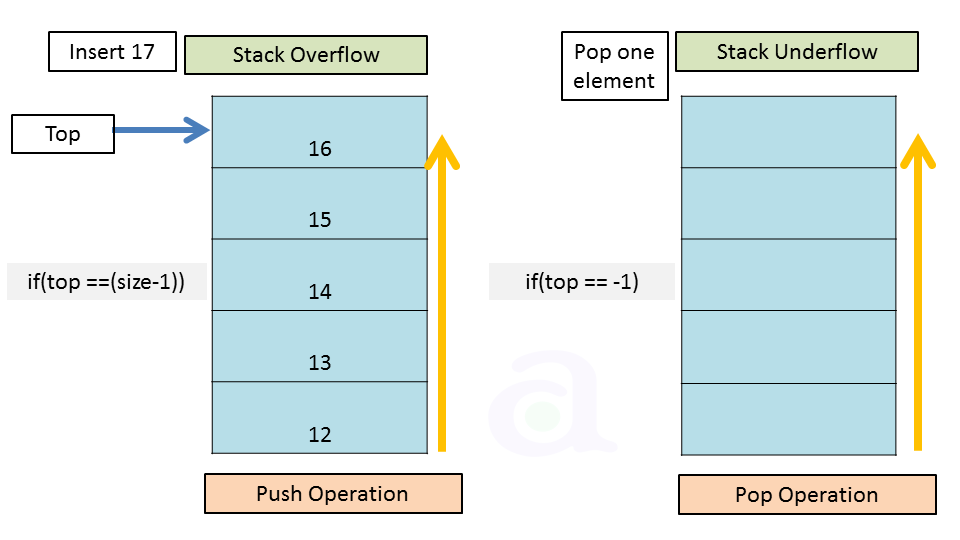
Stack Implementation using array in Data Structure
Table of Content:
Implementation of stack
Stack can be easily implemented using an Array or a Linked List. Arrays are quick, but are limited in size and Linked List requires overhead to allocate, link, unlink, and deallocate, but is not limited in size. Here we will implement Stack using array.
Array Implementation of Stacks
Implementation of stack using array avoids pointers and is probably the more popular solution. The only potential hazard with this strategy is that we need to declare an array size ahead of time. Generally this is not a problem, because in typical applications, even if there are quite a few stack operations, the actual number of elements in the stack at any time never gets too large. It is usually easy to declare the array to be large enough without wasting too much space. If this is not possible, then a safe course would be to use a linked list implementation.

If we use an array implementation, the implementation is trivial. Associated with
each stack is the top of stack, top, which is -1 for an empty stack (this is how
an empty stack is initialized). To push some element d onto the stack, we
increment top and then set STACK[tos] = d, where STACK is the array representing
the actual stack. To pop, we set the return value to STACK[top] and then
decrement top. Of course, since there are potentially several stacks, the STACK
array and top are part of one structure representing a stack. It is almost always
a bad idea to use global variables and fixed names to represent this (or any)
data structure, because in most real-life situations there will be more than one
stack. When writing your actual code, you should attempt to follow the model as
closely as possible, so that no part of your code, except for the stack routines,
can attempt to access the array or top-of-stack variable implied by each stack.
This is true for all ADT operations. Modern languages such as Ada and C++ can
actually enforce this rule.
Implementation Steps
push() Function:
A simple algorithm for Push operation can be derived as follows
/* Definition of the push function */
void push(int s[], int d)
{
if(top ==(size-1)) // Checking for overflow
flag = 0;
else
{
flag = 1;
++top;
s[top] = d;
}
}
pop() Function:
A simple algorithm for Pop operation can be derived as follows
/* Definition of the pop function */
int pop(int s[])
{
int popped_element;
if(top == -1) // Cheking for underflow
{
popped_element = 0;
flag = 0;
}
else
{
flag = 1;
popped_element = s[top];
--top;
}
return (popped_element);
}
dispaly() Function to show the list
/* Definition of the display function */
void display(int s[])
{
int i;
if(top == -1)
{
printf("\n Stack is empty");
}
else
{
for(i = top; i >= 0; --i)
printf("\n %d", s[i] );
}
}
Full Code to Implementaion the stack using array
Implementation of this algorithm in C, is very easy. See the following code ?
/* IMPLEMENTATION OF THE STACK USING ARRAYS */ /* STACK_A.C */ # include<stdio.h> # include<string.h> # include<ctype.h> # define size 100 int top = -1; int flag = 0; int stack[size]; void push(int *, int); int pop(int *); void display(int *); /* Definition of the push function */ void push(int s[], int d) { if(top ==(size-1)) flag = 0; else { flag = 1; ++top; s[top] = d; } } /* Definition of the pop function */ int pop(int s[]) { int popped_element; if(top == -1) { popped_element = 0; flag = 0; } else { flag = 1; popped_element = s[top]; --top; } return (popped_element); } /* Definition of the display function */ void display(int s[]) { int i; if(top == -1) { printf("\n Stack is empty"); } else { for(i = top; i >= 0; --i) printf("\n %d", s[i] ); } } /* Function main */ void main() { int data; char choice; int q = 0; int top = -1; do { printf(" \nPush->i Pop->p Quit->q:"); printf("\nInput the choice : "); do { choice = getchar(); choice =tolower(choice); }while(strchr("ipq",choice)==NULL); printf("Your choice is: %c",choice); switch(choice) { case 'i' : printf("\n Input the element to push:"); scanf("%d", &data); push(stack, data); if(flag) { printf("\n After inserting "); display(stack); if(top == (size-1)) printf("\n Stack is full"); } else printf("\n Stack overflow after pushing"); break; case 'p' : data = pop(stack); if(flag) { printf("\n Data is popped: %d", data); printf("\n Rest data in stack is as follows:\n"); display(stack); } else printf("\n Stack underflow" ); break; case 'q': q = 1; } } while(!q); }
Push->i Pop->p Quit->q: Input the choice : i Your choice is: i Input the element to push:12 After inserting 12 Push->i Pop->p Quit->q: Input the choice : i Your choice is: i Input the element to push:13 After inserting 13 12 Push->i Pop->p Quit->q: Input the choice : i Your choice is: i Input the element to push:14 After inserting 14 13 12 Push->i Pop->p Quit->q: Input the choice : p Your choice is: p Data is popped: 14 Rest data in stack is as follows: 13 12 Push->i Pop->p Quit->q: Input the choice : q Your choice is: qPress any key to continue . . .